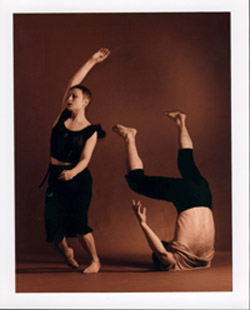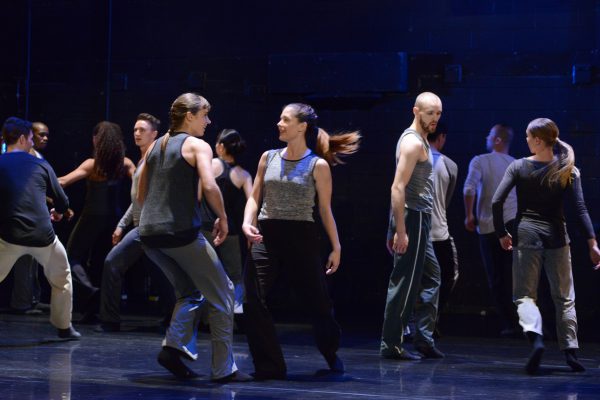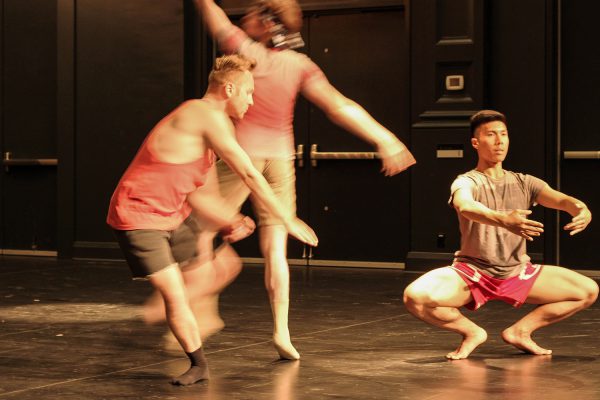Yvonne Ng’s two-part work, “Signs” is a well-mixed suspension of text, movement, music and percussion in a fluid performance of theatrical dance. Katherine Duncanson composed a new score for the first dance “Paper Women”, and Lee Pui Ming created a work for “Emerald Lies”. Ng also invited poet Lindsay Zier-Vogel to contribute to the creative process by translating into poetic language the physicality of the choreography she observed in rehearsals. Her word images were used to generate new movements that inspired more word images.
The title “Signs” might refer to this fecund relationship between words, sounds and movements, including some improvisational elements in the performance. The origin of the dance is Ng’s memories of being a schoolgirl in South Asia, and so one thinks too about the signs of those times, signs of change, and signs as unifiers or pointers that lend a commonality to individual experiences. There is something of the same, for example, in all the girls in “Paper Women.” They are symbols of both the similarities and differences in Ng’s separate lives in Canada and South Asia.
Before “Paper Women” begins we hear the girls talking off stage, singing and laughing. There is a row of small containers on the floor at the front of the stage, and we also hear a monotone, persistent chord on the organ coming from one of the two musicians located in the shadows of the metal balcony running along the walls of the theatre (Harbourfront Centre Theatre in Toronto). Seven women enter and the dance begins with a horizontal line proceeding forward from the back of the stage across its width. The women face the audience not so much aggressively as with a sense of directness and knowledge of our presence in the audience.
They seem fragile in papery white crêpe dresses that reveal the outlines of their bodies. In an often-repeated movement with arms stretched out in a high V, fingers quivering and heads bowed, one is reminded of a chain of paper dolls, and also of the fluttering of butterflies or delicate white moths. At different moments, the paper women convey a sense of wonder, innocence, strength, and also defiance. They transform in green lighting to creatures slithering on the floor. Their movements are integrated with fantastic percussion imagery provided by the musicians in subtle response.
Each performance of “Paper Women” is different because the dancers follow instructions written on pieces of paper picked from the glass containers at the front. The notes, which they pin to their frocks, become symbols of their truancy as schoolgirls. In the context of the dance, the flapping pinned notes also signify the dancers’ playful inventiveness, self assertion and, strangely enough, their willingness to conform to the rules of their game-playing.
It is not an unhappy dance, though it is, at times, intense and somber. With each new selection of instructions from the containers comes a transition. The exchange between words and movement becomes comedy in a tag improvisation game. The two musicians act as referees and commentators watching from above: “Jen, you’re flashing your underwear. Get off the stage!” Amy, you forgot to tag, you’re out.” “Nice balance, bad attitude. Get off the stage!” “Love that smile, Kate.” The improv ironically spoofs the command of language and musicians over the dancers.
Near the end of the dance a shift occurs, with the women grouped together in the centre front of the stage. They hold their arms behind their backs, looking up with slack, open mouths and eyes shut. Their hips sway side to side as they step foot to foot. They look like moths caught in a warm yellow light or blind, innocent little moles, creaturely, in a transitory stasis. One by one, the dancers peel off from the group moving to dimly lit areas of the stage. The last of them lights a candle in each container. The others improvise in a solitude punctuated by moments of synchronized pauses, with wide spread feet, arms open to the side, palms up and elbows bent. Otherwise, they move in curves and swirls, and in the expansive breadth of arms and legs a sense of maturity is conveyed. They are no longer girls.
The second dance, “Emerald Lies”, presents another side to schoolgirls. A dancer enters the stage before all the others. Her movements, in the single spotlight on the darkened stage, are more angular and aggressive. The other dancers enter and what we see is a dance about the cruelty of girls toward one another. Their spins, floor rolls and other gestures are aggressive and attacking. The heat of their battles is visible in the burnt orange-red crêpe costumes that they wear. In a line facing away from the audience, they call out familiar childhood taunts to an outcast dancer: “Who do you think you are?” “I hate you!” “We’re not talking to you any more!” The rejected girl holds up her head with her hands, scuttling on the balls of her feet. The other dancers mimic her movements, uttering whimpered cooing sounds in the transition to a new formation.
We’re told in the program notes that Ng was bullied by a childhood friend who both loved and hated her, and who confessed lying to others about Ng in a letter written in emerald green ink. The resolution of the dance comes in a strange twist from bullying rejection to sycophantic adoration.
Although “Signs” is rooted in her schoolgirl memories, the dance is not just an expressionist reflection of Ng’s emotional experiences. The aesthetic of the work is more contemporary. The dancers’ child-like innocence stems not only from their portrayal of schoolgirls, but from an aesthetic quality in their movements. They show something of their own personalities on stage, they seem less theatrical, their technique less formal though still dancerly. Their lines are never extreme extensions like those of a classical ballet dancer. Their movements are athletic, but not exaggeratedly so. These are humans, who quite obviously have a wider physical vocabulary and range of motion than the average non-dancer, but their language is not extreme or highly formalistic and unnatural in ways, for example, that ballet and traditional modern dance can sometimes seem. The aesthetic of “Signs” is rooted more in storytelling, poetry, emotional language and a movement vocabulary developed in relation to the expressive potential of these specific dancers.
Ng is, no doubt, a skilled choreographer in command of her medium. Her knowledge of the craft is second nature, like driving a car. One is never distracted by technical concerns for her dancers or about the choreography. The audience can engage fully in the world created by the movements, uninterrupted by virtuosic athleticism. There is, however, a curious tension between the dancers’ outward performance focus and their playful intimacy with one another as they carry out the dance. Perhaps what we see is a result of the many hours spent together in the studio over two years. We see a relaxed familiarity between the seven women and the musicians as they pull together their ideas for a performance.
Although Ng’s subject matter may not be of interest to everyone, the work never bores. The contrast between “Paper Women” and “Emerald Lies” brings to mind William Blake’s “Songs of Innocence and Experience.” The view in “Emerald Lies” is not nearly as desolate as in some of Blake’s poems, but the contrast of childhood innocence with destruction in human relationships is similar.
Tagged: Contemporary, Performance, ON , Toronto





